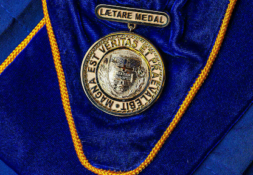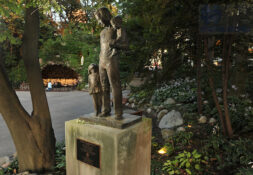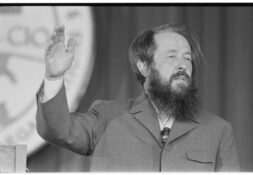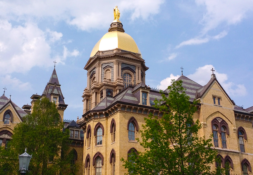Klau Center Takes Up “Inquiry of Our Times” with Lecture Series
The Klau Center for Civil and Human Rights continued its “Building an Anti-racist Vocabulary” lecture series on Friday, September 24 with a presentation from author and activist, Courtney Martin. This lecture—the third in a semester-long series—focused on the meaning and implications of the phrase “school choice” from an anti-racist perspective using Martin’s own experience as a mother making decisions about her daughter’s education.
The Klau Center’s weekly lecture series invites a prominent speaker each week to examine a particular subject that relates to the anti-racist view of systemic racism and racial justice. In doing so, the Klau Center hopes to raise awareness for and encourage the adoption of anti-racism—which this week’s lecturer termed “the inquiry of our times.”
The Center’s webpage for the lecture series emphasizes the centrality of the anti-racist framework to the project’s mission. Citing Ibram X. Kendi’s widely discussed book How to Be an Anti-racist, the webpage highlights the distinction between being an “anti-racist” and being “not racist,” by claiming that the latter category is an untenable middle ground that cannot exist with the current state of racial inequities.
For Martin, school choice—an ostensibly race-neutral practice by which students are able to attend (and direct their attached education funding) to whatever school they and their families choose—is an example of an issue where being “not racist” is not enough.
She explains this view by using her own experience as a well-educated, relatively affluent white woman who relocated to a gentrified neighborhood in Oakland with her family a few years back. The discomforting reality that soon confronted her was that the public school in her new neighborhood looked very differently than its surroundings; the school was 10 percent white compared to 40 percent of the whole neighborhood, due to many white families sending their children to better rated schools outside of the local public school system. Martin provided evidence for this trend on a broader scale as well by noting that nationwide schools have actually become more racially segregated since 1988. For the anti-racist, this sort of disparity is a certain indicator of racial bias within the relevant system or institutions.
But as Martin noted, this was a neighborhood that prided itself on its ethnic diversity and progressive outlook. So, why was there such a disparity in a place where the vast majority of people were assuredly “not racist?” The key, Martin concluded, was that there was a wide “gap between what [every person] believes and how they live their lives.” While the people in Martin’s neighborhood held highly progressive views on the subject of racial equity, they were unwilling to take the necessary actions to fight against the existing systems that upheld the same racial inequity.
According to Martin, in order for people to overcome this disconnect between their professed beliefs and actions, they need to stop making decisions based on a false sense of individual priorities and view these issues through a systemic lens. When talking about an arena as intimate as the family, Martin acknowledged that this claim can lead to some pretty radical conclusions. but ultimately she accepts it as necessary when dealing with such a deeply ingrained problem.
Therefore, Martin has no issue claiming that the common refrain of parents “wanting the best for their kids” is the true source of the racial disparities that arise from school choice because it creates a “ladder” that inevitably leaves some kids on the bottom rung. Rather, Martin contends that parents should embrace a method that evaluates how their choice will affect the community as a whole.
This approach was what spurred Martin to choose to send her daughter to the local public school when she was old enough, even as many of her like-minded neighbors chose better-rated schools for their children. But she acknowledges that this was a tough decision and that—even with the right intentions—it is easy to slide into the trap of merely being “not racist” rather than acting “anti-racist.” This realization is why she approaches racial issues with the painstaking approach of acting “suspicious” towards anything that allows her to “slip out of existential and ethical angst.”
Martin’s assessment and approach underscores the heart of the anti-racist movement that the Klau Center’s lecture series seeks to better understand and promote: Anti-racism goes beyond attempting to change minds and hearts on the issue of race and rather focuses on critically examining all systems and institutions in our society, with the goal of transforming those where any racial disparity can be found. This desire to uproot and transform larger systems includes both personal actions like Martin’s and greater steps that directly target institutions. The Klau Center’s lecture series will cover both these approaches as it seeks to give those in the Notre Dame community a more comprehensive and positive view of what it means to be anti-racist. Future lecture topics are “Courageous Christianity” as presented by Jemar Tisby on October 1, “Athletic Protests” as presented by Howard Bryant on October 9, and “Workplace Diversity” as presented by Frank Dobbin on October 16.
Luke Thompson is a Sophomore from Flagstaff, Arizona majoring in the Program of Liberal Studies, Political Science, and Theology. He enjoys hiking around northern Arizona and playing basketball when he’s not buried in books or obsessing over college football. He can be reached at lthomps7@nd.edu.
Image credit: University of Notre Dame, Klau Center for Civil and Human Rights





